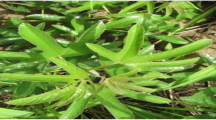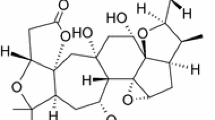Abstract
Carthamus tinctorius L. is commonly known as Safflower. C. tinctorius extracts and oil are important in drug development with numerous pharmacological activities in the world. This plant is cultivated mainly for its seed, which is used as edible oil. For a long time C. tinctorius has been used in traditional medicines as a purgative, analgesic, antipyretic and an antidote to poisoning. It is a useful plant in painful menstrual problems, post-partum hemorrhage and osteoporosis. C. tinctorius has recently been shown to have antioxidant, analgesic, anti-inflammatory and antidiabetic activities. Carthamin, safflower yellow are the main constituents in the flower of C. tinctorius. Carthamidin, isocarthamidin, hydroxysafflor yellow A, safflor yellow A, safflamin C and luteolin are the main constituents which are reported from this plant. Caryophyllene, p-allyltoluene, 1-acetoxytetralin and heneicosane were identified as the major components for C. tinctorius flowers essential oil. Due to the easy collection of the plant and being widespread and also remarkable biological activities, this plant has become both food and medicine in many parts of the world. This review presents comprehensive analyzed information on the botanical, chemical and pharmacological aspects of C. tinctorius.
Similar content being viewed by others
References
Shirwaikar A, Khan S, Kamariya YH, Patel BD, Gajera FP. Medicinal plants for the management of post-menopausal osteoporosis: a review. Open Bone J 2010;2:1–13.
Bae CS, Park CH, Cho HJ, Han HJ, Kang SS, Choi SH, et al. Therapeutic effects of safflower (Carthamus tinctorius L.) seed powder on osteoporosis. Korean J Electron Microscopy 2002;32:285–290.
Zargari A. Medicinal plants. Vol 2. Iran: Tehran University Press; 1988:619.
Kumar SP, Kumari BDR. Factors affecting on somatic embryogenesis of safflower (Carthamus tinctorius L) at morphological and biochemical levels. World J Agri Sci 2011;7:197–205.
Knowles PF, Ashri A. In: Smartt J, Simmonds NW, eds. Evolution of crop plants. 2nd ed. Harlow, UK: Longman; 1995:47–50.
Weiss EA. In: Anonymous, eds. Safflower. London, UK: Longman Group Limited, Longman House; 1983:216–281.
Wang G, Li Y. Clinical application of safflower (Carthamus tinctorius). Zhejiang Tradit Chin Med Sci J (Chin) 1985;1:42–43.
Zhou FR, Zhao MB, Tu PF. Simultaneous determination of four nucleosides in Carthamus tinctorius L. and Safflower injection using highperformance liquid chromatography. J Chin Pharmaceut Sci (Chin) 2009;18:326–330.
Punjanon T, Arpornsuwan T, Klinkusoom N. The pharmacological properties of safflower (Carthamus tinctorius L). Bull Health Sci Technol 2004;7:51–63.
Madaan N, Mudgal V, Mishra S, Srivastava AK, Singh RB. Studies on biochemical role of accumulation of heavy metals in Safflower. Open Nutraceuticals J 2011;4:199–204.
Kruawan K, Kangsadalampai K. Antioxidant activity, phenolic compound contents and antimutagenic activity of some water extract of herbs. Thai J Pharm Sci 2006;30:28–35.
Jun MS, Ha YM, Kim HS, Jang HJ, Kim YM, Lee YS, et al. Antiinflammatory action of methanol extract of Carthamus tinctorius involves in heme oxygenase-1 induction. J Ethnopharmacol 2011;133:524–530.
Almeida RN, Navarro DS, Barbosa-Filho JM. Plants with central analgesic activity. Phytomed 2001;8:310–322.
Kasahara Y, Kumaki K, Sato T, Katagiri S. Pharmacological studies on flower petals of Carthamus tinctorius central actions and anti-inflammation. Shoyakugaku Zasshi 1989;43:331–338.
Hiramatsu M, Takahashi T, Komatsu T, Kido T, Kasahara Y. Antioxidant and neuroprotective activities of mogami-benibana (Safflower, Carthamus tinctorius Linne). Neurochem Res 2009;34:795–805.
Sellami IH, Ben Salah H, Kchouk ME, Marzouk B. Variations in phytosterol composition during the ripening of Tunisian safflower (Carthamus tinctorius L.) seeds. Pak J Bio Sci 2007;10:3829–3834.
Kim SK, Cha JY, Jeong SJ, Chung CH, Choi YR, Cho YS. Properties of the chemical composition of safflower (Carthamus tinctorius L.) sprout. Korean J Life Sci 2000;10:68–73.
Zhang HL, Nagatsu A, Watanabe T, Sakakibara J, Okuyama H. Antioxidative compounds isolated from safflower (Carthamus tinctorius L.) oil cake. Chem Pharm Bull 1997;45:1910–1914.
Park JB. Serotomide and safflomide modulate forskolin stimulated cAMP formation via 5-HT1receptor. Phytomed 2008;15:1093–1098.
Zhao G, Qin GW, Gai Y, Guo LH. Structural identification of a new tri-p-coumaroylspermidine with serotonin transporter inhibition from safflower. Chem Pharm Bull 2010;58:950–952.
Akihisa T, Yasukaw K, Oinuma H, Kasahara Y, Yamanouchi S, Takido M, et al. Triterpene alcohols from the flowers of compositae and their anti-inflammatory effects. Phytochem 1996;43:1255–1260.
Onodera J, Obara H, Osone M. The structure of Safflomin-A a component of safflower yellow. Chem Lett 1981;3:433–436.
** Y, **ao YS, Zhang FF. Systematic screening and characterization of flavonoid glycosides in Carthamus tinctorius L. by liquid chromatography/UV diode-array detection/electrospray ionization tandem mass spectrometry. J Pharm Biomed Anal 2008;46:418–430.
Jiang TF, Lv ZH, Wang YH. Separation and determination of chalcones from Carthamus tinctorius L. and its medicinal preparation by capillary zone electrophoresis. J Sep Sci 2005;28:1244–1247.
Zhou YZ, Ma HY, Chen H. New acetylenic glucoside from Carthamus tinctorius. Chem Pharm Bull 2006;54:1455–1456.
**ao PG, Liu CX. Pharmacology, pharmacokinetics and toxicology of Chinese traditional medicine for stroke therapy. Asian J Drug Metabol Pharmacokin 2005;5:83–124.
Lee JY, Chang EJ, Kim HJ, Park JH, Choi SW. Antioxidative flavonoids from leaves of Carthamus tinctorius. Arch Pharm Res 2002;25:313–319.
Meselhy MR, Kadota S, Momose Y, Hatakeyama N, Kusai A, Hattori M, et al. Two new quinochalcone yellow pigments from Carthamus tictorius and calcium antagonistic activity of tictormine. Chem Pharm Bull 1993;41:1796–1802.
Huang JL, Fu ST, Jiang YY, Cao YB, Guo ML, Wang Y, et al. Protective effects of Nicotiflorin on reducing memory dysfunction, energy metabolism failure and oxidative stress in multi-infarct dementia model rats. Pharm Biochem Behav 2007;86:741–748.
Akihisa T, Nozaki A, Inoue Y, Yasukawa K, Kasahara Y, Motohashi S, et al. Alkane diols from flower petals of Carthamus tinctorius. Phytochem 1997;45:725–728.
Shao JF, Wang YB, Chen Q, Liu ZQ, Liu Q, Cai WG, et al. A daily variation in essential oil composition of flower of different accessions from Carthamus tinctorius L. in Sichuan province of China. J Med Plant Res 2011;5:3042–3051.
Hyun TK, Kim JS. The pharmacology and clinical properties of Kalopanax pictus. J Med Plants Res 2009;3:613–620.
Shokrzadeh M, Saeedi Sarvari SS. Chemistry, pharmacology and clinical properties of Sambucus ebulus: a review. J Med Plants Res 2009;4:95–103.
Rhee MH, Park HJ, Cho JY. Salicornia herbaceae: botanical, chemical and pharmacological review of halophyte marsh plant. J Med Plants Res 2009;3:548–555.
Lundberg IE. Clinical symptoms in patients with myositisan acquired metabolic myopathy idiopathy inflammation myopathies: why do the muscles become weak? Curr Opin Rheumatol 2003;15:675–678.
Walsh LJ. Mast cells and oral inflammation. Crit Rev Oral Biol Med 2003;14:188–198.
Huang ZL, Yu ML, Qu SK, Shan ML, Song CQ. Studies on the immuno-activity of the polysaccharide from safflower (Carthamus tinectorius). Chin Trad Herb Drugs 1984;15:213–216.
Chen CY, Peng WH, Tsai KD, Hsu SL. Luteolin suppresses inflammation-associated gene expression by blocking NF-κB and AP-1 activation pathway in mouse alveolar macrophages. Life Sci 2007;81:1602–1614.
López-Lázaro M. Distribution and biological activities of the flavonoid luteolin. Mini Rev Med Chem 2009;9:31–59.
Mohsin A, Shah AH, Al-Yahya MA, Tariq M, Tanira MOM, Ageel AM. Analgesic, antipyretic activity and phytochemical screening of some plants used in traditional Arab system of medicine. Fitoterapia 1989;60:174–177.
Zhu HB, Zhang L, Wang ZH, Tian JW, Fu FH, Liu K, et al. Therapeutic effects of hydroxysafflor yellow A on focal cerebral ischemic injury in rats and its primary mechanisms. J Asian Nat Prod Res 2005;7:607–613.
Li HX, Han SY, Wang XW, Ma X, Zhang K, Wang L, et al. Effects of the carthamins yellow from Carthamus tinctorius L. on hemorheological disorders of blood stasis in rats. Food Chem Toxicol 2009;47:1797–1802.
Halliwell B, Gutteridge JMC. Role of free radicals and catalytic metal ions in human disease: an overview. Method Enzymol 1995;186:1–85.
Wiseman SA, Balentine DA, Frei B. Antioxidants in tea. Crit Rev Food Sci Nutr 1997;37:705–718.
Mates JM, Perez-Gomez C, Nunez de Castro I. Antioxidant enzymes and human diseases. Clin Biochem 1999;32:595–603.
Aruoma OI. Methodological considerations for characterizing potential antioxidant actions of bioactive components in plant foods. Mutat Res 2003;523–524.
Hemati A, Azarnia M, Angaji AH. Medicinal effects of Heracleum persicum (Golpar). Middle-East J Sci Res 2010;5:174–176.
Hogg N. Free radicals in disease. Seminars Reproduct Endocrinol 1998;16:241–248.
Cho JY, Prak SC, Kim TW, Kim KS, Song JC, Kim SK, et al. Radical scavenging and anti-inflammatory activity of extracts from Opuntia humifusa. Raf J Pharm Pharmacol 2006;58:113–119.
Cai Y, Luo Q, Sun M, Corke H. Antioxidant activity and phenolic compounds of 112 traditional Chinese medicinal plants associated with anticancer. Life Sci 2003;74:2157–2184.
Calomme M, Pieters L, Vlietinck A, Berghe DV. Inhibition of bacterial mutagenesis by Citrus flavonoids. Planta Med 1996;62:222–226.
Koyama N, Kuribayashi K, Seki T, Kobayashi K, Furuhata Y, Suzuki, et al. Serotonin derivatives, major safflower (Carthamus tinctorius L.) seed antioxidants, inhibit low-density lipoprotein (LDL) oxidation and atherosclerosis in apolipoprotein E-deficient mice. J Agric Food Chem 2006;54:4970–4976.
Alam MR, Kim SM, Lee JI. Effects of Safflower seed oil in osteoporosis induced-ovariectomized rats. Am J Chin Med 2006;34:601–612.
Jang HO, Park YS, Lee JH. Effect of extracts from safflower seeds on osteoblast differentiation and intracellular calcium ion concentration in MC3T3-E1 cells. Nat Prod Res 2007;21:787–797.
Kim HJ, Bae YC, Park RW. Bone-protecting effect of safflower seeds in ovariectomized rats. Calcif Tissue Int 2002;71:88–94.
Yuk TH, Kang JH, Lee SR, Yuk SW, Lee KG, Song BY, et al. Inhibitory effect of Carthamus tinctorius L. seed extracts on bone resorption mediated by tyrosine kinase, COX-2 (cyclooxygenase) and PG (prostaglandin) E2. Am J Chin Med 2002;30:95–108.
Paramesha M, Ramesh CK, Krishna V, Ravi Kumar YS, Parvathi KMM. Hepatoprotective and in vitro antioxidant effect of Carthamus tinctorius L, var Annigeri-2-, an oil-yielding crop, against CCl4 -induced liver injury in rats. Pharmacogn Mag 2011;7(28):289–297.
Moon KD, Back SS, Kim JH, Jeon SM, Lee MK, Choi MS. Safflower seed extract lowers plasma and hepatic lipids in rats fed high-cholesterol diet. Nutr Res 2001;21:895–904.
Arpornsuwan T, Changsr K, Roytrakul S, Punjanon T. The effects of the extracts from Carthamus tinctorius L. on gene expression related to cholesterol metabolism in rats. Songklanakarin J Sci Technol 2010;32:129–136.
Asgary S, Rahimi P, Mahzouni P, Madani H. Antidiabetic effects of hydroalcoholic extract of Carthamus tinctoriuss L. in alloxaninduced diabetic rats. J Res Med Sci 2012;17:386–392.
Takahashi T, Miyazawa M. Potent α-glucosidase inhibitors from safflower (Carthamus tinctorius L.) seed. Phytother Res 2012;26:722–726.
Author information
Authors and Affiliations
Corresponding author
Rights and permissions
About this article
Cite this article
Asgarpanah, J., Kazemivash, N. Phytochemistry, pharmacology and medicinal properties of Carthamus tinctorius L.. Chin. J. Integr. Med. 19, 153–159 (2013). https://doi.org/10.1007/s11655-013-1354-5
Received:
Published:
Issue Date:
DOI: https://doi.org/10.1007/s11655-013-1354-5




